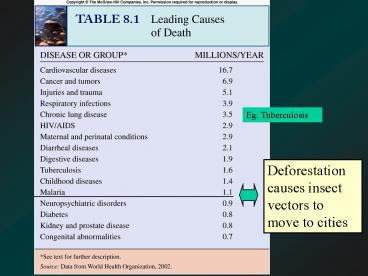Eg: Tuberculosis PowerPoint PPT Presentation
1 / 27
Title: Eg: Tuberculosis
1
Eg Tuberculosis
Deforestation causes insect vectors to move to
cities
2
Morbidity and Quality of Life
- Death rates do not tell everything about burden
of disease. - Total economic and social consequences of
diseases are difficult to obtain. - Disability-Adjusted Life Year (DALY) combines
premature deaths and loss of healthy life
resulting from illness or disability.
3
Elephantiasis caused by parasitic worm
At any given time, about 2 billion people suffer
from worms, protozoans, and other internal
parasites.
4
Emergent Diseases
- An emergent disease is one never known before, or
has been absent for at least 20 years. - An important factor in the spread of many
diseases is speed and frequency of modern travel. - Foot and Mouth Disease
- Ebola
5
Emerging Ecological Diseases
- Domestic animals and wildlife also experience
sudden and widespread epidemics. - Distemper (Seals)
- Chronic Wasting Disease (Deer and Elk)
- Transmissible Spongiform Encephalopathies
- Black Band Disease (Coral)
6
Recent outbreaks of lethal infectious diseases
At least 30 new infectious diseases have appeared
in the past two decades while many well-known
have reappeared in more virulent, drug-resistant
forms.
7
Factors Contributing to the Spread of Contagious
Diseases
- High population densities
- Settlers pushing into remote areas
- Human-caused environmental change (use of
fertilizers, pesticides etc) - Speed and frequency of modern travel
- Contact with water or food contaminated with
human waste
8
Antibiotic and Pesticide Resistance
- Indiscriminate use of antibiotics and pesticides
- perfect recipe for natural selection - Protozoan that causes malaria now resistant to
most antibiotics, and mosquitoes have developed
resistance to many insecticides - Drug resistance TB, Staph A, flesh-eating
bacteria
9
Toxins Movement, Distribution, Fate
Movement, fate of chemicals in the environment
(processes that modify, remove or sequester
compounds)
10
Toxins Movement, Distribution, Fate
Movement via Solubility - water - oil
Routes by which chemicals enter body determine
toxicity
11
Bioaccumulation and Biomagnification
- Bioaccumulation selective absorption storage
of molecules dilute toxins in the environment
can reach dangerous levels inside cells and
tissue - Biomagnification - the effects of toxins are
magnified through food webs
12
DDT - Powerful Insecticide, Harmless to Humans
13
Peregrine falcons disappeared from the eastern US
in 1960s due to excess pesticide use
14
Minimizing Toxic Effects
- Every material can be poisonous under some
conditions - Taken in small doses, most toxins can be broken
down or excreted before they do much harm
belief in 1800s, arsenic (Napolean) - Liver - primary site of detoxification
- Tissues and organs - high cellular reproduction
rates replace injured cells - down side tumors,
cancers possible
15
Measuring Toxicity
Animal Testing
- Most commonly used and widely accepted
- Expensive - hundreds of thousands of dollars to
test one toxin at low doses - Time consuming
- Often very inhumane
- Difficult to compare toxicity of unlike chemicals
or different species of organisms
16
A Typical Dose/Response Curve
17
LD50 - the dose of a toxin that is lethal to
half the test population
18
Acute Lethal Doses for Some Toxic Organic
Chemicals
mouse
rat
It is useful to group materials according to
their relative toxicity.
19
Acute Versus Chronic Doses and Effects
- Acute effect - immediate health effect caused by
a single exposure to a toxin (can be reversible) - Chronic effect - long lasting or permanent health
effect caused by (1) a single exposure to a very
toxic substance or (2) continuous or repeated
sublethal exposure to a toxin
20
Risk Assessment and Acceptance
- Risk - the probability of harm times the
probability of exposure - A number of factors influence how we perceive
relative risks associated with different
situations. - Accepting risks - we go to great lengths to avoid
some dangers, while gladly accepting others
21
(No Transcript)
22
(No Transcript)
23
Mckinney Schoch
24
Establishing Public Policy
In setting standards for environmental toxins,
we need to consider
- Combined effects of exposure to many different
sources of damage - Different sensitivities of members of the
population - Effects of chronic as well as acute exposures
25
Regulatory Decisions EPA framework
Other Factors Not Specific to the Problem
The Science Specific to the Problem
26
- How do we determine what the risk is from
different physical/ chemical changes in the
environment? - How much of the ranking is based on our values
do they reflect the science?
27
Summary
- Environmental Health Hazards
- Infectious Organisms
- Emergent Diseases
- Antibiotics and Pesticide Resistance
- Toxic Chemicals
- Distribution and Fate of Toxins
- Minimizing Toxic Effects
- Measuring Toxicity
- Risk Assessment
- Public Policy

